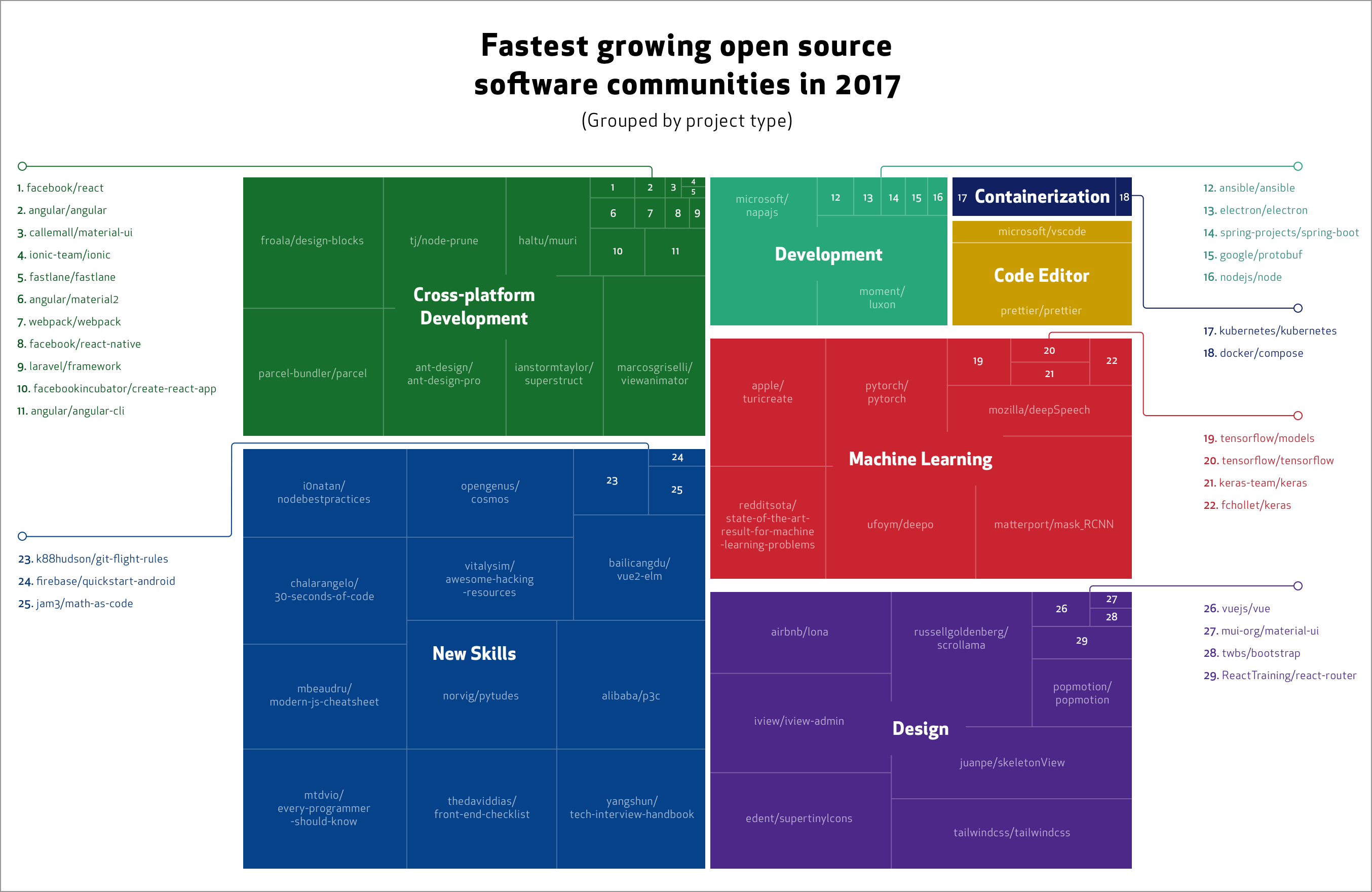Open source project trends for 2018
Last year, GitHub brought 24 million people from almost 200 countries together to code better and build bigger. From frameworks to data visualizations across more than 25 million repositories, you…

Last year, GitHub brought 24 million people from almost 200 countries together to code better and build bigger. From frameworks to data visualizations across more than 25 million repositories, you were busy in 2017—and the activity is picking up even more this year. With 2018 well underway, we’re using contributor, visitor, and star activity to identify some trends in open source projects for the year ahead.
Project trends

Cross-platform development
Some of the projects that experienced the largest growth in activity were focused on cross-platform or web development. For example, Angular/angular-cli had 2.2 times more contributors in 2017 than in 2016. You contributed more, visited more often, and starred projects related to Angular/Angular, Facebook/React, and Electron/Electron. These projects simplify the development process, shortening the time from start to deployment across desktop and mobile platforms.
Deep learning
You’ve also been rallying around deep learning projects. Across multiple industries, artificial intelligence is solving a host of complex and interesting problems. You’ve helped drive that interest by upping your contributions to and visits to projects like Keras-team/Keras and Mozilla/DeepSpeech. TensorFlow/TensorFlow had 2.2 times more visits in 2017 than in 2016, and TensowFlow/models had 5.5 times more visits!
New skills
Your commitment to developing coding skills is unparalleled. You starred projects, many created in 2017, related to learning to code, getting coding jobs, and coding best practices. For example, Chalarangelo/30-seconds-of-code and norvig/pytudes provide code examples in javascript and python respectively to help you brush up on your fluency in these languages. jwasham/coding-interview-university and yangshun/tech-interview-handbook provide resources for how to pass the interview process for software engineering roles. i0natan/nodebestpractices, alibaba/p3c, and thedaviddias/Front-End-Checklist provide best practices for writing code and organizing projects.
Methods
How did we discover these trends? We looked at three different types of activity. First, we identified the top 100 projects that had at least 2,000 contributors in 2016 and experienced the largest increase in contributors in 2017. We also identified the top 100 projects that received the largest increase in visits to the project’s repo in 2017. Finally, we identified the top 100 projects that received the most new stars in 2017. Combining these lists, we categorized projects into broad communities and looked at the communities that were the most represented at the top of the lists.
We were impressed with the range of creative projects that emerged. You scratched the itch to keep track of your favorite NBA teams from the command line while you code, and you still found time to create an Android app for journalists and activists to securely monitor their homes and offices. Well done!
Learn more
If you’d like to see a lot more data covering what the GitHub community was up to from September 2016 through September 2017 including the most forked projects, the most social projects, and the most reviewed projects, check out the report we released at Universe: The State of the Octoverse.
You can also see who top contributors to open source in 2017 were in Felipe Hoffa’s analysis on Medium.
And head over to our redesigned Explore experience to find the latest project collections and trending topics on GitHub.
Tags:
Written by
Related posts

The future of AI-powered software optimization (and how it can help your team)
We envision the future of AI-enabled tooling to look like near-effortless engineering for sustainability. We call it Continuous Efficiency.

Let’s talk about GitHub Actions
A look at how we rebuilt GitHub Actions’ core architecture and shipped long-requested upgrades to improve performance, workflow flexibility, reliability, and everyday developer experience.

GitHub Availability Report: November 2025
In November, we experienced three incidents that resulted in degraded performance across GitHub services.